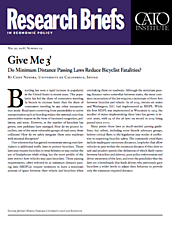One solution that has gained momentum among state lawmakers is additional traffic laws to protect bicyclists. Those laws may require bicyclists to wear helmets or may outlaw the use of headphones while riding, but the most prolific of the laws restrict how vehicles may pass bicyclists. Those passing requirements, often referred to as minimum distance passing laws (MDPLs), require motorists to leave a minimum amount of space between their vehicle and bicyclists when overtaking them on roadways. Although the minimum passing distance varies somewhat between states, the most common incarnation of the law requires a minimum of three feet between bicyclist and vehicle. As of 2014, twenty-six states and Washington, D.C. had implemented an MDPL. While the first MDPL was implemented in Wisconsin in 1974, the number of states implementing these laws has grown in recent years, with 24 of the 26 laws on record in 2014 being passed since 2000.
Many praise these laws as much-needed passing guidelines, but others, including some bicycle advocacy groups, believe critical flaws in the legislation may render it ineffective in improving bicyclist safety. The commonly cited flaws include inadequate minimum distances, loopholes that allow vehicles to pass within the minimum distance if they slow to safe and prudent speeds (the definition of which likely varies between bicyclists and drivers), poor police enforcement and driver awareness of the laws, and even the possibility that the laws set a benchmark that leads drivers who previously gave bicyclists a wider berth to adjust their behavior to provide only the minimum required distance.
My research quantifies the effects of MDPLs on bicyclist safety by analyzing 18,534 bicyclist fatalities across the United States. I use variation in the states that implement MDPLs, as well as the timing of implementation in individual states, to identify these effects while controlling for weather, demographics, and other factors. In other words, I compare states that enacted an MDPL to states that never enacted an MDPL, before and after the passage of the law. Further, I control for the possibility that states implement the laws in reaction to increases in bicyclist numbers (and potentially bicyclist fatalities) by controlling for the number of bicyclist commuters in each state.
The initial analysis finds that MDPLs do not significantly decrease bicyclist fatalities. In fact, the results show that MDPLs may slightly increase bicyclist fatalities as evidenced by a persistent, though statistically insignificant, effect. Although the evidence that MDPLs increase bicyclist fatalities is far from conclusive, several factors might suggest such an outcome. As mentioned previously, MDPLs may effectively set a benchmark that could lead drivers who previously gave cyclists a much wider berth to adjust their behavior to provide only the minimum required distance. Another possibility is that drivers do not change their behavior after MDPL enactment because they are unaware of the law or for any other reason, but bicyclists are aware of the law and believe that motorists will now pass them more cautiously. This could potentially lead to bicyclists riding in a more reckless manner and increase bicycle collisions and fatalities.
The analysis then investigates the possibility that MDPLs have effects that vary over time. The results show no evidence of an “announcement” effect where drivers pass bicyclists more carefully for several months after MDPL implementation before returning to their old behavior. Conversely, I find no evidence of a delayed effect where MDPLs are ineffective for the first months after passage but eventually become effective as drivers learn about the laws and slowly adjust their behavior. These results suggest that the effects of MDPLs do not vary over time, and thus the insignificant result is not caused by announcement or delayed effects attenuating the estimates.
Beyond finding that MDPLS have a statistically insignificant effect on bicyclist fatalities, I also find that MDPLs have an economically insignificant effect. My results suggest that, at best, MDPLs prevent one bicyclist fatality per state every 20.41 months. While preventing even a single accidental death is undoubtedly a good thing, the evidence suggests that MDPLs are ineffective in reducing bicyclist fatalities.
Given the low costs of MDPLs, policymakers may still wish to enact them even if they are ineffective in reducing fatalities. However, it might be possible to decrease the number of bicyclist fatalities by altering MDPLs. These changes may be as easy as increasing the minimum passing distance or altering driver education courses to facilitate awareness of MDPLs. Although further research is needed to determine the effectiveness of these alterations, they could be implemented with either zero or very low additional costs.
NOTE:
This research brief is based on Cody Nehiba, “Give Me 3′: Do Minimum Distance Passing Laws Reduce Bicyclist Fatalities?,” Economics of Transportation, December 2017.

